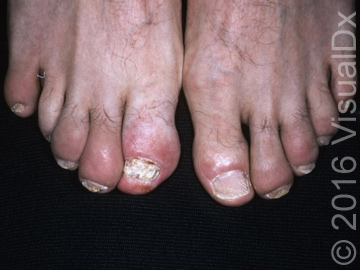A 33-year-old man visits his doctor complaining of a thick scaly plaque on his toes and toenails and low back pain.
Rheumatology Network Editorial Staff
September 9, 2019
Reactive arthritis
Reactive arthritis (ReA, previously called Reiter syndrome) is a type of spondyloarthropathy that occurs 1-4 weeks after a gastrointestinal or genitourinary infection.
ReA was initially described after infections with specific bacteria: Chlamydia trachomatis, Shigella, Salmonella, Yersinia, and Campylobacter. However, recent studies have implicated Clostridium difficile, Giardia, and other atypical infections as triggers for ReA. As in other spondyloarthropathies, ReA is associated with HLA-B27. While the joint fluid in ReA is sterile, bacterial antigens in the synovium (as opposed organisms) are thought to induce an immune response.
Onset is most commonly noted between 20-40 years of age and in those of Caucasian descent. Males and females are equally affected where arthritis follows a gastrointestinal infection, but males are more affected where the condition has been triggered by C trachomatis.
Only a minority of patients present with the "classic" triad of arthritis, urethritis (or cervicitis), and conjunctivitis. ReA usually presents as an acutely painful oligoarthritis (fewer than 5 joints), usually of the lower extremities. Patients can also complain of stiffness and pain of the lower back. Enthesitis (inflamed tendon and ligament insertion points) is especially common, and dactylitis (sausage digits) can also be seen. Conjunctivitis is typically bilateral and mucopurulent.
Mucocutaneous findings include balanitis circinata, circinate vulvitis, keratoderma blenorrhagicum, and oral ulcers.
Patients occasionally have systemic features, including fever, weight loss, and fatigue. Rarely there may be cardiac conduction abnormalities, aortic insufficiency, pericarditis, pleuritis, or nephropathy.
For most patients, ReA is a self-limited disease, and they recover completely within 2-6 months. A chronic arthritis may persist in a minority, usually in association with HLA-B27 phenotype. Other patients can develop recurrent episodes of ReA after encountering the same organism.
Cutaneous involvement has been reported to be more frequent and severe in patients with ReA and HIV/AIDS.
Source: rheumatologynetwork.com/ima...
LUpus Patients Understanding & Support (LUPUS):
